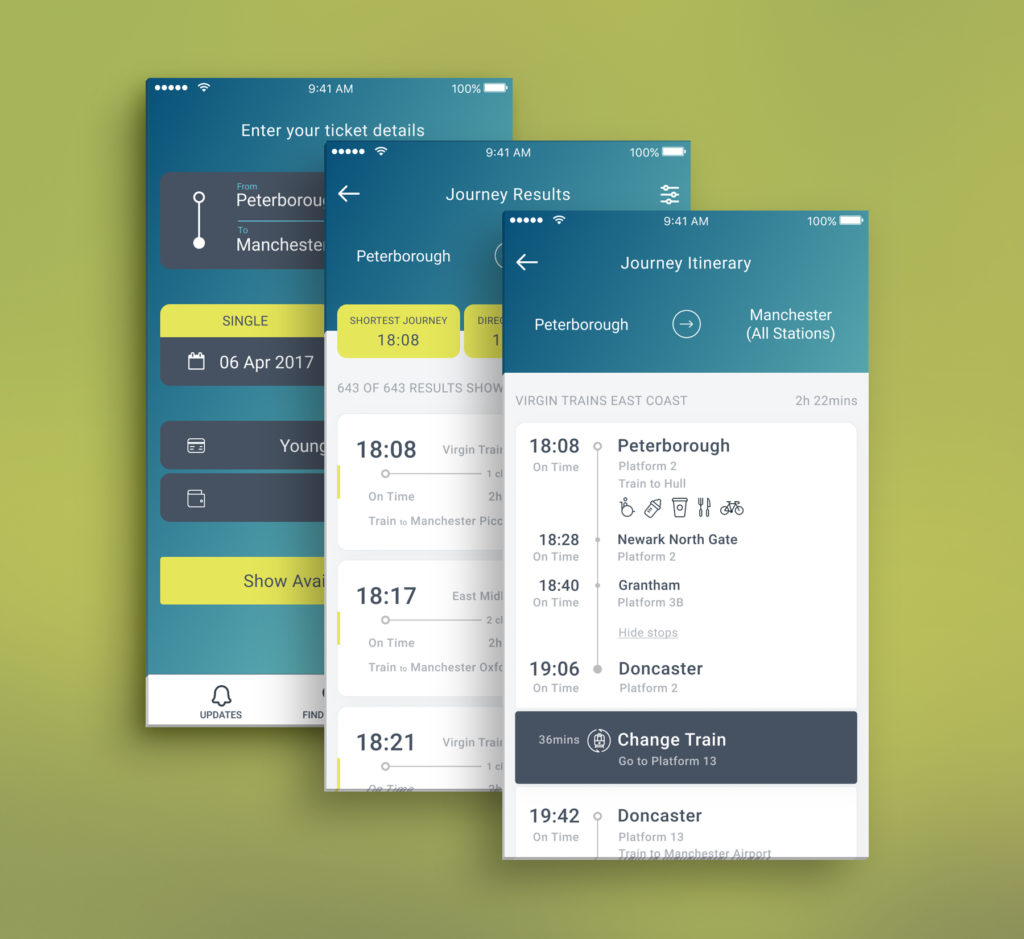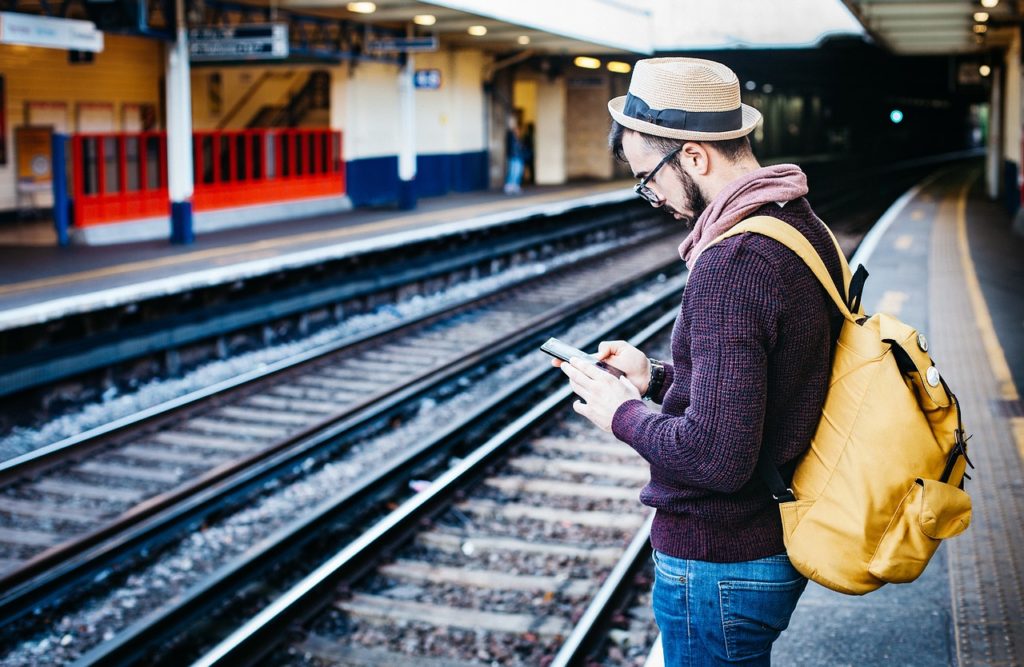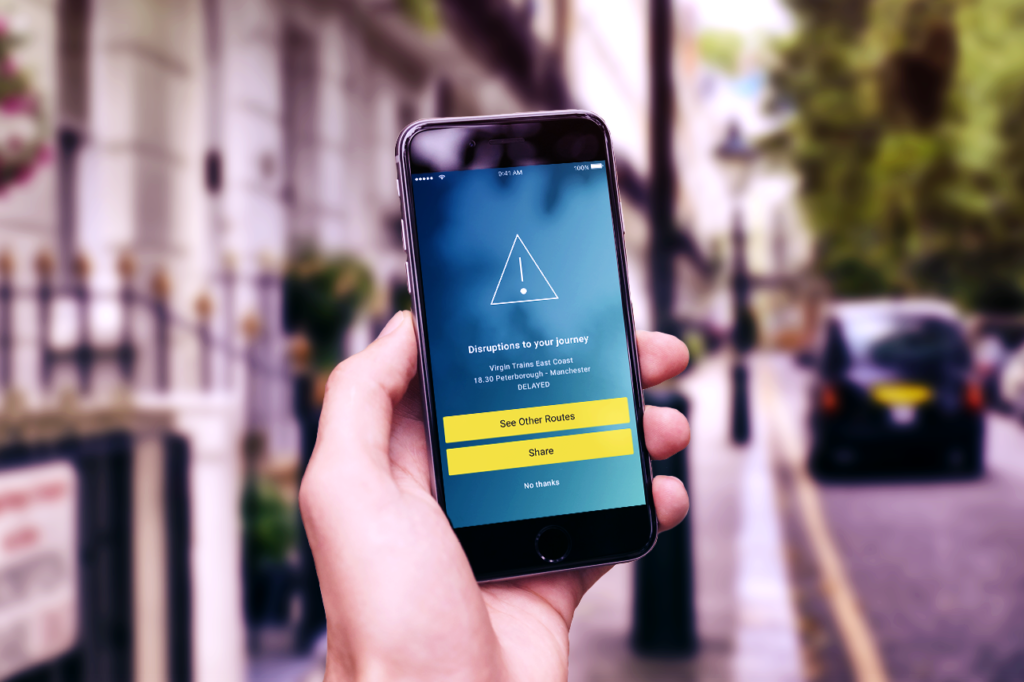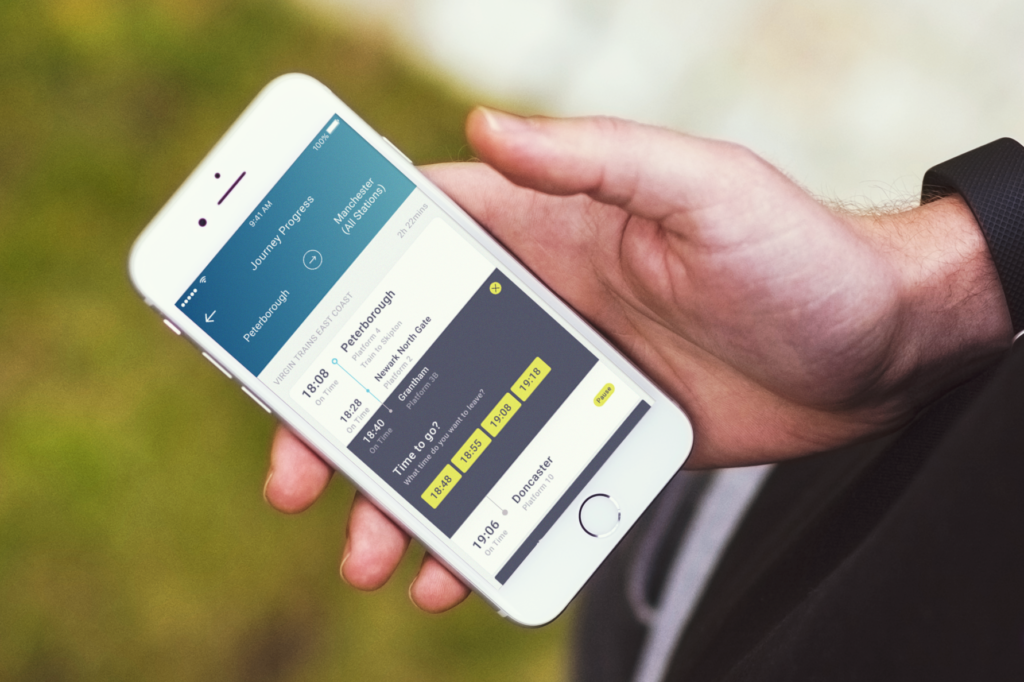An iOs application prototype for train travellers
Summary
As a commuter for 20 years I can say train services have been progressively getting better on my line from Hitchin to London.
Until this year, when a huge timetable change made delays and cancellations commonplace.
They also had trains go from St. Pancras and Kings Cross. This has really impacted our journeys, not to mention our train catching split times.
Most that get the train are not happy. Stranded at stations, not knowing how to get home, trains cancelled.
We are delighted to be given the chance to build a prototype iOS application using the RDG timetable, disruption web services and location technologies to help rail travellers get to their destination with more information and less stress.
In this project, we interviewed commuters, built prototype screens that we user tested and built a working iOS application integrated with the RDG timetable and transport services.
We are currently testing the prototype and hope to be building a full application in Q4 2018.
Until this year, when a huge timetable change made delays and cancellations commonplace.
They also had trains go from St. Pancras and Kings Cross. This has really impacted our journeys, not to mention our train catching split times.
Most that get the train are not happy. Stranded at stations, not knowing how to get home, trains cancelled.
We are delighted to be given the chance to build a prototype iOS application using the RDG timetable, disruption web services and location technologies to help rail travellers get to their destination with more information and less stress.
In this project, we interviewed commuters, built prototype screens that we user tested and built a working iOS application integrated with the RDG timetable and transport services.
We are currently testing the prototype and hope to be building a full application in Q4 2018.
About the RDG (Rail Delivery Group)
The Rail Delivery Group exists to enable rail companies to succeed in transforming and delivering a successful railway. All the passenger and freight rail companies are members of the RDG, as well as Network Rail and HS2.
The RDG provides services and support to enable train operating companies to succeed in transforming and delivering a successful railway, benefiting customers, taxpayers and the economy.
Train Operating Companies are under more scrutiny than ever.
Mòr are working with the customer experience arm of RDG. The aim is to simplify travel for customers and to provide a concierge-style application to help them through their journeys.
Our objective was to have the application do the hard work so the user didn’t need to and were just directed to the best train to complete the journey.
The RDG provides services and support to enable train operating companies to succeed in transforming and delivering a successful railway, benefiting customers, taxpayers and the economy.
Train Operating Companies are under more scrutiny than ever.
Mòr are working with the customer experience arm of RDG. The aim is to simplify travel for customers and to provide a concierge-style application to help them through their journeys.
Our objective was to have the application do the hard work so the user didn’t need to and were just directed to the best train to complete the journey.
The Rail Delivery Group application gives people information before they need it and helps them plan the next step. No more waiting for a train no knowing what is going on.
The Challenge
Living in Hitchin and commuting into London for the best part of 20 years means we at Mòr know a thing or two about trains.
We all have commuter stories, I used to be able to get off the Victoria line at Kings Cross and could make the train on platform 0-8 in 1 minute 45 seconds.
If it was platform 9-11 it was around 2 minutes getting into the door as the beeps were going off and the door was closing. I took pride in this. However, my swift commute and time optimisation sometimes meant I would jump on the wrong train.
Or even a train that usually stopped at Stevenage would take me all the way to Peterborough… Also when things go wrong, things really go wrong. And no one knows what is going on.
We actually think that train services, at least in our area, have been progressively getting better. Until this year, when a huge timetable change made delays and cancellations commonplace.
So the train lines are pretty bad. On top of this, different train companies use common or ambiguous terms that are similar in some cases and different in others. Off-peak, peak times, terms like “any given route” or “all London stations” can differ from provider to provider. It is confusing for a customer to know exactly where they can use their ticket and what train they can get, including what company they can use.
We were challenged to create an application that helps people get where they need to go.
We all have commuter stories, I used to be able to get off the Victoria line at Kings Cross and could make the train on platform 0-8 in 1 minute 45 seconds.
If it was platform 9-11 it was around 2 minutes getting into the door as the beeps were going off and the door was closing. I took pride in this. However, my swift commute and time optimisation sometimes meant I would jump on the wrong train.
Or even a train that usually stopped at Stevenage would take me all the way to Peterborough… Also when things go wrong, things really go wrong. And no one knows what is going on.
We actually think that train services, at least in our area, have been progressively getting better. Until this year, when a huge timetable change made delays and cancellations commonplace.
So the train lines are pretty bad. On top of this, different train companies use common or ambiguous terms that are similar in some cases and different in others. Off-peak, peak times, terms like “any given route” or “all London stations” can differ from provider to provider. It is confusing for a customer to know exactly where they can use their ticket and what train they can get, including what company they can use.
We were challenged to create an application that helps people get where they need to go.
How we helped
Our application lets a customer know what train will get them to their destination quickest.
This works in real time, based on the customer's location and the ticket they have purchased. If customers need to make a change to their journey, a disruption occurs or they need to leave a train there are normally a load of questions. Which train can they get next? Will their ticket be valid? Are there any delays on the line? What is the fastest route? The application prototype we built was intended to put an end to that.
We interviewed rail passengers and created a clickable prototype of the application in Axure. We then tested this again with rail travellers.
Once we were happy with the flow of the application we applied a minimal design to it. The idea was that it could be easily re-branded for each train operating company if needed. We ran the UX and design for the project using Agile Scrum methodology.
Once the design was in place and tested we built an iOS prototype with integrated Rail Delivery Group services. We built this with our team in the UK and India, with continuous testing performed on the development.
We could input ticket details to the application, and the application had the up to date timetables and disruptions services fed into it. At the time there were relatively few testable disruptions. I know this may seem hard to believe. So we needed to mock-up disruption examples so we could test the services. The application dealt with where the user should get off, and next trains.
We were working with the RDG SOAP/XML data services along with location technology to allow the application to determine where a customer is and the best way for them to get to their destination given their ticket type and the status of the rail.
The application will also be useful to station workers and staff positioned on the trains.
No longer will customers not know when they will arrive home! We are currently testing this with rail users and are hoping to build a production-ready application in Q4 2018. So if we can’t make the trains themselves better at least we can help make the experience better…
This works in real time, based on the customer's location and the ticket they have purchased. If customers need to make a change to their journey, a disruption occurs or they need to leave a train there are normally a load of questions. Which train can they get next? Will their ticket be valid? Are there any delays on the line? What is the fastest route? The application prototype we built was intended to put an end to that.
We interviewed rail passengers and created a clickable prototype of the application in Axure. We then tested this again with rail travellers.
Once we were happy with the flow of the application we applied a minimal design to it. The idea was that it could be easily re-branded for each train operating company if needed. We ran the UX and design for the project using Agile Scrum methodology.
Once the design was in place and tested we built an iOS prototype with integrated Rail Delivery Group services. We built this with our team in the UK and India, with continuous testing performed on the development.
We could input ticket details to the application, and the application had the up to date timetables and disruptions services fed into it. At the time there were relatively few testable disruptions. I know this may seem hard to believe. So we needed to mock-up disruption examples so we could test the services. The application dealt with where the user should get off, and next trains.
We were working with the RDG SOAP/XML data services along with location technology to allow the application to determine where a customer is and the best way for them to get to their destination given their ticket type and the status of the rail.
The application will also be useful to station workers and staff positioned on the trains.
No longer will customers not know when they will arrive home! We are currently testing this with rail users and are hoping to build a production-ready application in Q4 2018. So if we can’t make the trains themselves better at least we can help make the experience better…



